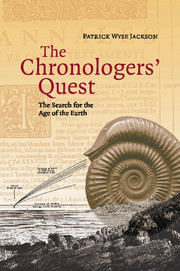Book contents
- Frontmatter
- Contents
- List of illustrations
- List of tables
- Preface
- Acknowledgements
- 1 The ancients: early chronologies
- 2 Biblical calculations
- 3 Models of Aristotelian infinity and sacred theories of the Earth
- 4 Falling stones, salty oceans, and evaporating waters: early empirical measurements of the age of the Earth
- 5 Thinking in layers: early ideas in stratigraphy
- 6 An infinite and cyclical Earth and religious orthodoxy
- 7 The cooling Earth
- 8 Stratigraphical laws, uniformitarianism and the development of the geological column
- 9 ‘Formed stones’ and their subsequent role in biostratigraphy and evolutionary theory
- 10 The hour-glass of accumulated or denuded sediments
- 11 Thermodynamics and the cooling Earth revisited
- 12 Oceanic salination reconsidered
- 13 Radioactivity: invisible geochronometers
- 14 The Universal problem and Duck Soup
- Bibliography
- Index
2 - Biblical calculations
Published online by Cambridge University Press: 02 December 2009
- Frontmatter
- Contents
- List of illustrations
- List of tables
- Preface
- Acknowledgements
- 1 The ancients: early chronologies
- 2 Biblical calculations
- 3 Models of Aristotelian infinity and sacred theories of the Earth
- 4 Falling stones, salty oceans, and evaporating waters: early empirical measurements of the age of the Earth
- 5 Thinking in layers: early ideas in stratigraphy
- 6 An infinite and cyclical Earth and religious orthodoxy
- 7 The cooling Earth
- 8 Stratigraphical laws, uniformitarianism and the development of the geological column
- 9 ‘Formed stones’ and their subsequent role in biostratigraphy and evolutionary theory
- 10 The hour-glass of accumulated or denuded sediments
- 11 Thermodynamics and the cooling Earth revisited
- 12 Oceanic salination reconsidered
- 13 Radioactivity: invisible geochronometers
- 14 The Universal problem and Duck Soup
- Bibliography
- Index
Summary
In any second-hand bookstore one can find old copies of the King James Bible, often bound in black leather with gilt-edged pages, shelved high up out of reach. These neglected volumes were more often than not prizes awarded by some religious group such as the Attercliff Baptist Sunday School for proficiency in answering questions on scripture, and signed by the local cleric and superintendent. How many of the beneficiaries of such prizes would have noticed the odd inscription ‘Before CHRIST 4004’ or ‘4004 bc’ printed in black or occasionally red ink either in the margins or between two columns of versified text at the opening of the Book of Genesis? If they did, what did they make of it? What questions did this figure conjure up in their minds and how often was it debated on Sundays?
Shout ‘4004 bc’ in a crowded lift travelling to the fifteenth floor of an office building, or in a coffee shop on a Sunday morning, and 50% of the occupants will think they are sharing space with some crazed individual and want to get as far away from you as possible, while the other 50% will probably think either ‘Creation’ or ‘Ussher’. As many people know, 4004 bc is the date of the Creation arrived at by James Ussher (1580–1656), Archbishop of Armagh, in Ireland. However, he was not the first person to attempt to date Creation using the pages of the Bible, nor was he the last.
- Type
- Chapter
- Information
- The Chronologers' QuestThe Search for the Age of the Earth, pp. 13 - 31Publisher: Cambridge University PressPrint publication year: 2006



